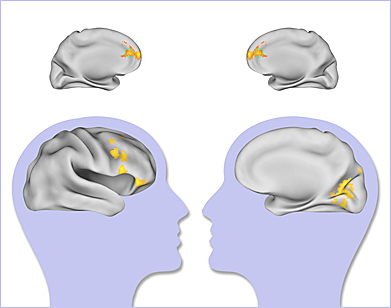Study indicates autism linked gene change alters brain’s internal wiring
Brain images of youth who have a variation in a gene associated with autism spectrum disorders (ASD) revealed an altered pattern in the brain’s connective wiring, according to researchers funded by the National Institutes of Health.
 |
| When they analyzed patterns of brain activity in the frontal lobe (above), the researchers found that in the brains of children with variations in the CNTNAP2 gene (lower left), activity was concentrated in nearby areas of the frontal lobe. In contrast, children with the common form of the gene (lower right) were more likely to show brain activity deep in the back of the brain. [Brain images rendered using CARET software developed at the Washington University School of Medicine. |
The gene appears to impair the formation of long distance communications between different parts of the brain. The study is among the first to investigate the effects of a specific gene associated with autism on brain activity.
The gene, CNTNAP2 (contactin-associated protein-like 2) is active in the developing fetus. CNTNAP2 contains the information for a protein that links early brain cells together to form networks that convey information from one part of the brain to another. Along with autism spectrum disorders, variations in CNTNAP2 have been linked to Specific Language Impairment, a disorder affecting speech and reading ability, and to schizophrenia, Tourette syndrome, and Attention Deficit Hyperactivity Disorder.
The researchers used a brain scanning technique known as functional magnetic resonance imaging (fMRI) to chart the participants’ brain activity when they performed a simple computer task.
Each set of scans revealed a distinct pattern of connections that corresponded with each of the two versions of the gene. In children with typical versions of the gene, the scans showed a network that connected activity in the frontal lobe to regions on the left side of the brain involved in language and to regions of the rear of the brain. The frontal lobe, located behind the forehead, is involved with planning, organizing, judgment, and abstract thinking.
In contrast, among children with CNTNAP2 variations associated with autism and other disorders, activity originating in the frontal lobe, just behind the forehead, was tightly linked with other nearby regions within the right and left sides of the frontal lobe. Connections from the frontal lobe to the back of the brain were greatly reduced. The ASDs are a group of developmental disabilities affecting social interactions and communication. Symptoms vary greatly from person to person. Studies of twins suggest that ASD has a strong genetic component.
The ASDs are thought usually to result from not a single gene, but from a combination of one or more genes, perhaps interacting with other factors. Although dozens of genetic variants have been linked with these disorders, no consistent pattern of variant genes has been identified among individuals diagnosed with ASD. Moreover, many of these genetic variants are found in people who do not have ASD. Researchers believe that this large number of genes exerts their effects on a much smaller number of brain systems and functions. A variation in any one of a group of genes could affect a pathway through which brain cells communicate, for example, or hinder the growth of individual brain cells, or transmission between individual brain cells.
“This finding is among the first to show how a gene associated with autism may affect communications within the brain,” said Alan E. Guttmacher, M.D., director of the Eunice Kennedy Shriver National Institute of Child Health and Human Development (NICHD), the NIH institute that funded the study. “Additional studies, of single genes and combinations of genes, may reveal subtypes of autism spectrum based upon biological causation, rather than types of behavior. Ultimately, the hope is that such knowledge will make it possible to tailor treatment to each individual, perhaps based on a scan of the genes involved.”
First author Ashley Scott-Van Zeeland, Ph.D., of the University of California, Los Angeles (UCLA) and Scripps Translational Science Institute conducted the research with 10 UCLA colleagues, including senior author Susan Bookheimer.
Their findings appear in Science Translational Medicine.
Dr. Scott-Van Zeeland and her team first collected brain scans from 32 boys between 10 and 14 years old. Half of the boys had an ASD and half did not; a total of nine from both groups had the ASD-associated variation of CNTNAP2.
The researchers recorded brain activity while the boys concentrated on a game. The researchers’ analysis of this activity enabled them to map connections between activity in the frontal lobe and other parts of the brain revealing the two distinct patterns of communication.
The researchers then collected a second set of scans from 39 typically developing boys and girls with and without CNTNAP2 variations associated with ASD and other disorders. The researchers, confirmed the same patterns of impaired connection among those with CNTNAP2 variations.
“Even in an entirely different set of kids, the maps were remarkably similar,” said Dr. Scott-Van Zeeland. “This suggests common patterns of wiring in the brain that predispose a subset of children to conditions such as ASD. Future studies will help us understand how these genetic differences shape networks of activity in the very young and as children develop and age.”
###
The NICHD sponsors research on development, before and after birth; maternal, child, and family health; reproductive biology and population issues; and medical rehabilitation. For more information, visit the Institute's Web site at http://www.nichd.nih.gov/.
The National Institutes of Health (NIH) — The Nation's Medical Research Agency — includes 27 Institutes and Centers and is a component of the U. S. Department of Health and Human Services. It is the primary federal agency for conducting and supporting basic, clinical, and translational medical research, and it investigates the causes, treatments, and cures for both common and rare diseases. For more information about NIH and its programs, visit http://www.nih.gov.

 BACK TO TOP
BACK TO TOP